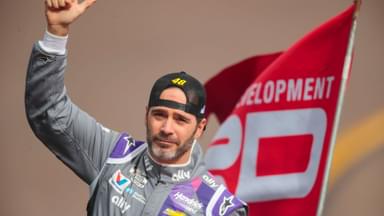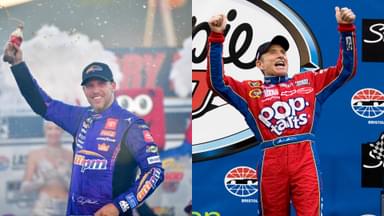As six NASCAR stock cars turned laps at one of Japan’s circuits for the “USA Motorsports Culture Introduction Demo Run,” staged during the final round of the 2025 Super Taikyu Series at Fuji Speedway on November 15–16, John Hunter Nemechek stood among the select group of drivers representing the sport. Sunday’s main event opened with Nemechek seeing fans waving American flags from the grandstands as the cars were rolled to the grid.
Advertisement
Following that, Toyota Chairman Akio Toyoda even climbed into Nemechek’s car and drove several laps himself. But for Nemechek, visiting Japan for the first time came with more than just exploring a new country. He hadn’t anticipated NASCAR’s footprint reaching so far across the Pacific, but he was surprised to witness it firsthand.
While wandering through a thrift shop in Tokyo, he stumbled upon a Jimmie Johnson rookie-season Daytona 500 pole sitter shirt from 2002. And then, he came across vintage NASCAR apparel and memorabilia featuring Dale Earnhardt Jr., Dale Earnhardt Sr., and various Winston Cup Racing-branded items.
When he reached the checkout counter, the employee helping him pulled out a stack of additional T-shirts; everyone from Bobby Labonte to Greg Biffle and Travis Kvapil was represented. Seeing such a broad collection of classic NASCAR names convinced him that the sport’s reach overseas ran deeper than he imagined.
Reflecting on the entire trip, he said, “I don’t know if it could have gone much better. The way the fans embraced it, the way that everyone who went had smiles all around. It was an amazing experience.”
“The one common thing I’d say from the trip is that everyone was smiling the entire time, and that makes you feel good as a driver, for a team owner from Jimmie’s standpoint, the manufacturer of Toyota, and even from the fan base,” he continued.
He noticed that the fans had traveled from China, Thailand, and the Middle East, all converging on Fuji to see NASCAR up close because it was the closest the series had ever been to them. Autograph sessions became a window into those stories, and he said those conversations left him deeply appreciative of the sport’s global pull.
Japan may have been the furthest he had traveled with NASCAR, but it wasn’t the sport’s first international venture. NASCAR previously held exhibition races in Japan during the 1990s, running events at the Suzuka Circuit in 1996 and 1997, followed by a race at Twin Ring Motegi in 1998.
Those non-championship events were part of a three-year contract and showcased NASCAR regulars and international competitors coming together. The inaugural race, the NASCAR Thunder Special Suzuka, took place in November 1996. Japan, clearly, hasn’t forgotten those drivers or the imprint NASCAR left during that brief but memorable era, it seems.







